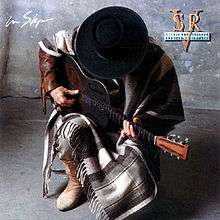In Step
In Step is the fourth studio album by Stevie Ray Vaughan and Double Trouble released in 1989. The title In Step can be seen as referring to Vaughan's new-found sobriety, following the years of drug and alcohol use that eventually led Vaughan into rehabilitation. It was also Vaughan's final album with Double Trouble. In 1990, he recorded a collaboration album with his brother, Jimmie Vaughan, called Family Style; later that year, Stevie Ray Vaughan died in a helicopter crash.
| In Step | ||||
|---|---|---|---|---|
 | ||||
| Studio album by | ||||
| Released | June 6, 1989 | |||
| Recorded | January 25–March 13, 1989 at Kiva Studios, Memphis, Tennessee; Sound Castle and Summa Studios, Los Angeles, CA | |||
| Genre | Blues rock, jazz blues | |||
| Length | 40:53 | |||
| Label | Epic | |||
| Producer | Double Trouble, Jim Gaines | |||
| Stevie Ray Vaughan chronology | ||||
| ||||
Reception
| Review scores | |
|---|---|
| Source | Rating |
| Allmusic | |
| Robert Christgau | A−[2] |
Reviews for In Step have generally been positive. Robert Christgau rated the album an A-, signifying "a very good record." Although he stated that "Wall of Denial" and "Tightrope" fall into ex-addict jargon like it was natural speech" and that "if the music was preachy or wimpy this would be a disaster," he concluded that "House Is Rockin'" keeps on boogieing on and that on the mood-jazz closer he escapes the blues undamaged for the first time in his career."[2]
Lou Reed selected In Step as one of his 'picks of 1989'.[3]
In a retrospective review, Stephen Thomas Erlewine of Allmusic rated In Step five out of five stars. He noted that before the album was released, "his songwriting was hit or miss. Even when he wrote a classic modern blues song, it was firmly within the genre's conventions." He further stated that it helped "Vaughan found his own songwriting voice, blending blues, soul, and rock in unique ways, and writing with startling emotional honesty." Although he stated that "tunes like the terse "Tightrope" and the dense "Wall of Denial" feel so intensely personal, it's hard to believe that they weren't the product of just one man", he also stated that "the lighter numbers [...] are just as effective as songs." He concluded that "it's fully realized, presenting every facet of Vaughan's musical personality, yet it still soars with a sense of discovery. It's a bittersweet triumph, given Vaughan's tragic death, [...] yet it's a triumph all the same."[1]
Track listing
- "The House Is Rockin'" (Doyle Bramhall, Vaughan) – 2:24
- "Crossfire" (Bill Carter, Ruth Ellsworth, Chris Layton, Tommy Shannon, Reese Wynans) – 4:10
- "Tightrope" (Bramhall, Vaughan) – 4:40
- "Let Me Love You Baby" (Willie Dixon) – 2:43
- "Leave My Girl Alone" (Buddy Guy) – 4:15
- "Travis Walk" (instrumental) (Vaughan) – 2:19
- "Wall of Denial" (Bramhall, Vaughan) – 5:36
- "Scratch-N-Sniff" (Bramhall, Vaughan) – 2:43
- "Love Me Darlin'" (Chester Burnett) – 3:21
- "Riviera Paradise" (instrumental) (Vaughan) – 8:49
Bonus tracks
The 1999 reissue adds the following tracks:
- "SRV Speaks" (Vaughan) – 1:33
- "The House is Rockin'" (Live) (Bramhall, Vaughan) – 2:48
- "Let Me Love You Baby" (Live) (Dixon) – 3:46
- "Texas Flood" (Live) (Larry C. Davis, Joseph W. Scott) – 7:28
- "Life Without You" (Live) (Vaughan) – 13:17
Personnel
- Double Trouble
- Stevie Ray Vaughan – guitar, vocals
- Tommy Shannon – bass guitar
- Chris Layton – drums, percussion
- Reese Wynans – keyboards
- Additional personnel
- Texacali Horns – on "Crossfire" and "Love Me Darlin'"
- Joe Sublett – saxophone
- Darrell Leonard – trumpet
Charts
Album
| Chart (1989) | Peak
position |
|---|---|
| Australian Albums (ARIA)[4] | 36 |
| Dutch Albums (Album Top 100)[5] | 44 |
| New Zealand Albums (RMNZ)[6] | 16 |
| Swedish Albums (Sverigetopplistan)[7] | 41 |
| Swiss Albums (Schweizer Hitparade)[8] | 18 |
| UK Albums (OCC)[9] | 63 |
| US Billboard 200[10] | 33 |
Singles - Billboard (North America)
| Year | Single | Chart | Position |
|---|---|---|---|
| 1989 | "Crossfire" | Mainstream Rock Tracks | 1 |
Certifications
| Region | Certification | Certified units/sales |
|---|---|---|
| Canada (Music Canada)[11] | Gold | 50,000^ |
| United States (RIAA)[12] | 2× Platinum | 2,000,000^ |
|
*sales figures based on certification alone | ||
References
- Erlewine, Stephen Thomas. In Step at AllMusic. Retrieved December 11, 2011.
- Christgau, Robert. "CG:Stevie Ray Vaughan and Double Trouble". Retrieved December 11, 2011.
- Rolling Stone, March 8, 1990
- "Australiancharts.com – Stevie Ray Vaughan and Double Trouble – {{{album}}}". Hung Medien. Retrieved May 20, 2020.
- "Dutchcharts.nl – Stevie Ray Vaughan and Double Trouble – {{{album}}}" (in Dutch). Hung Medien. Retrieved May 20, 2020.
- "Charts.nz – Stevie Ray Vaughan and Double Trouble – {{{album}}}". Hung Medien. Retrieved May 20, 2020.
- "Swedishcharts.com – Stevie Ray Vaughan and Double Trouble – {{{album}}}". Hung Medien. Retrieved May 20, 2020.
- "Swisscharts.com – Stevie Ray Vaughan and Double Trouble – {{{album}}}". Hung Medien. Retrieved May 20, 2020.
- "Stevie Ray Vaughan and Double Trouble | Artist | Official Charts". UK Albums Chart. Retrieved May 20, 2020.
- "Stevie Ray Vaughan and Double Trouble Chart History (Billboard 200)". Billboard. Retrieved May 20, 2020.
- "Canadian album certifications – Stevie Ray Vaughan And Double Trouble – In Step". Music Canada.
- "American album certifications – Stevie Ray Vaughan And Double Trouble – In Step". Recording Industry Association of America. If necessary, click Advanced, then click Format, then select Album, then click SEARCH.